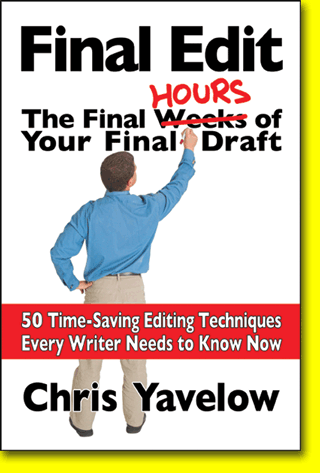He said, "said she."
Mar-08-2013 Filed in: dialogue
I have been drawn into an increasing number of discussions about the acceptability of inverted attributions; for example, the inversion of “he said,” into “said he.” So much so, that I put together a little program to check how the matter and added it to FictionFixer. At the moment, it simply counts a close quote character followed by “said” versus the total occurrences of “said”; later, I will take direct versus indirect dialog into consideration. Here are some of the results, randomly chosen, rounded up to the nearest percent when possible.
Clive Barker, Coldheart Mountain: 19 out of 1525 = 1%
Dan Brown, The Da Vinci Code: 2 out of 536 = 0.4%
Sandra Brown, Heaven’s Price: 0 out of 291 = 0%
Sandra Brown, The Witness: 0 out of 400 = 0%
Sandra Brown, Exclusive: 9 out of 621 = 1%
Tom Clancy, Patriot Games: 10 out of 694 = 1%
Tom Clancy, Red Storm Rising: 25 out of 552 = 5%
Michael Crichton, Timeline: 3 out of 1675 = 0.2%
Michael Crichton, Jurassic Park: 8 out of 2038 = 0.4%
William Faulkner, Sanctuary: 0 out of 1245 = 0%
John Grisham, Testament: 4 out of 543 = 0.4%
John Grisham, The Painted House: 11 out of 908 = 1%
Earnest Hemingway, For Whom the Bell Tools: 132 out of 2644= 5%
Jack Higgins, Prayer for the Dying: 2 out of 591 = 0.3%
John Irving, A Widow for One Year: 0 out of 1018 = 0%
Stephen King, The Shining: 1 out of 809 = 0.1%
Dean Koontz, What the Night Knows: 5 out of 377 = 1%
Dean Koontz, Odd Thomas: 5 out of 378 = 1%
Barack Obama, Dreams from my Father: 1 out of 637 = 0.2%
Nora Roberts, Dance of the Piper: 0 out of 90 = 0%
Sidney Sheldon, Rage of Angels: 0 out of 615 = 0%
All results are 1% or less, with only two from this test group exceeding that limit.
My gut feeling was that this usage might be evolving, so I tested a couple older novels; they seemed to confirm this suspicion:
Charlotte Bronte, Jane Eyre: 161 out of 583 = about 28%
Jane Austin, Pride and Prejudice: 241 out of 401 = 60%.
A similar feeling had me examine a couple novels written for the youth market:
C.S. Lewis, The Lion, the Witch, and the Wardrobe: 417 out of 535 = 78%
J.K. Rowling, Harry Potter (book 1): 698 out of 794 = 88%
I tested the inverted “asked” form, too, but I will save those results for another post. Likewise, the contemporary usage rules gleaned from the initial 21 results. These are easy to spot when one examines the group of inverted forms as a whole.
Clive Barker, Coldheart Mountain: 19 out of 1525 = 1%
Dan Brown, The Da Vinci Code: 2 out of 536 = 0.4%
Sandra Brown, Heaven’s Price: 0 out of 291 = 0%
Sandra Brown, The Witness: 0 out of 400 = 0%
Sandra Brown, Exclusive: 9 out of 621 = 1%
Tom Clancy, Patriot Games: 10 out of 694 = 1%
Tom Clancy, Red Storm Rising: 25 out of 552 = 5%
Michael Crichton, Timeline: 3 out of 1675 = 0.2%
Michael Crichton, Jurassic Park: 8 out of 2038 = 0.4%
William Faulkner, Sanctuary: 0 out of 1245 = 0%
John Grisham, Testament: 4 out of 543 = 0.4%
John Grisham, The Painted House: 11 out of 908 = 1%
Earnest Hemingway, For Whom the Bell Tools: 132 out of 2644= 5%
Jack Higgins, Prayer for the Dying: 2 out of 591 = 0.3%
John Irving, A Widow for One Year: 0 out of 1018 = 0%
Stephen King, The Shining: 1 out of 809 = 0.1%
Dean Koontz, What the Night Knows: 5 out of 377 = 1%
Dean Koontz, Odd Thomas: 5 out of 378 = 1%
Barack Obama, Dreams from my Father: 1 out of 637 = 0.2%
Nora Roberts, Dance of the Piper: 0 out of 90 = 0%
Sidney Sheldon, Rage of Angels: 0 out of 615 = 0%
All results are 1% or less, with only two from this test group exceeding that limit.
My gut feeling was that this usage might be evolving, so I tested a couple older novels; they seemed to confirm this suspicion:
Charlotte Bronte, Jane Eyre: 161 out of 583 = about 28%
Jane Austin, Pride and Prejudice: 241 out of 401 = 60%.
A similar feeling had me examine a couple novels written for the youth market:
C.S. Lewis, The Lion, the Witch, and the Wardrobe: 417 out of 535 = 78%
J.K. Rowling, Harry Potter (book 1): 698 out of 794 = 88%
I tested the inverted “asked” form, too, but I will save those results for another post. Likewise, the contemporary usage rules gleaned from the initial 21 results. These are easy to spot when one examines the group of inverted forms as a whole.


1s.jpg)
2s.jpg)